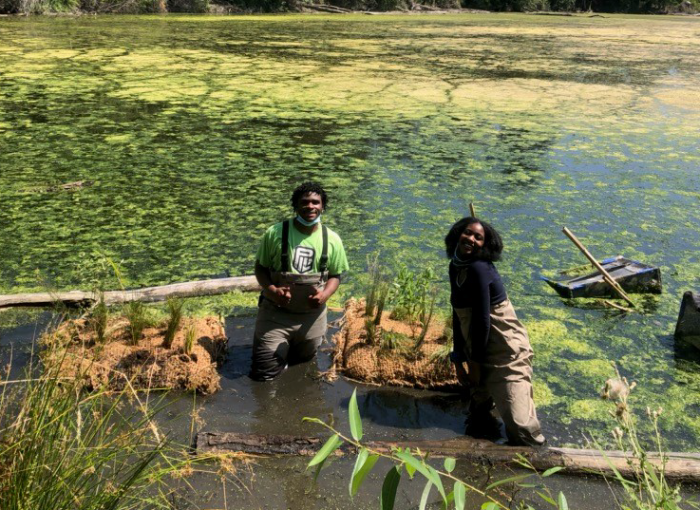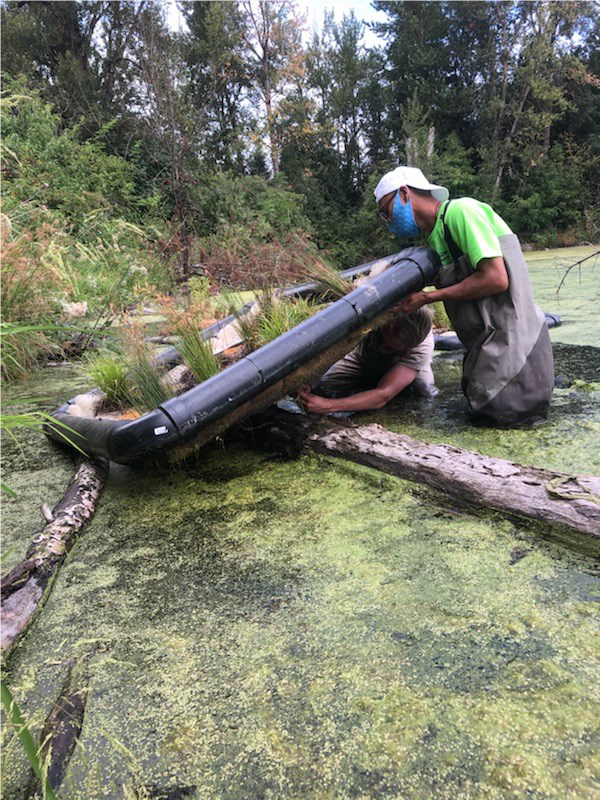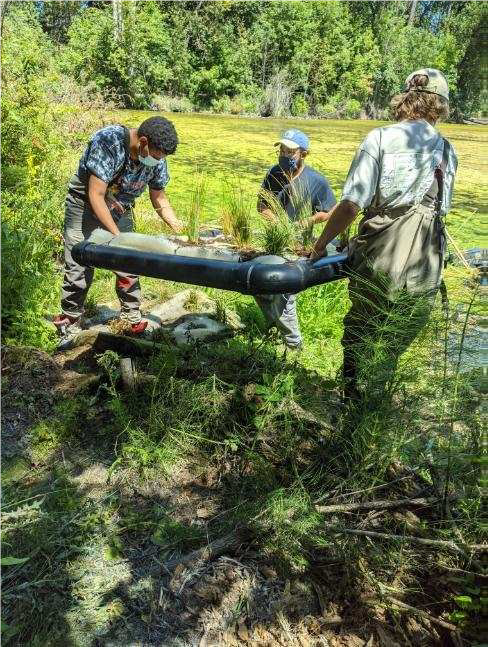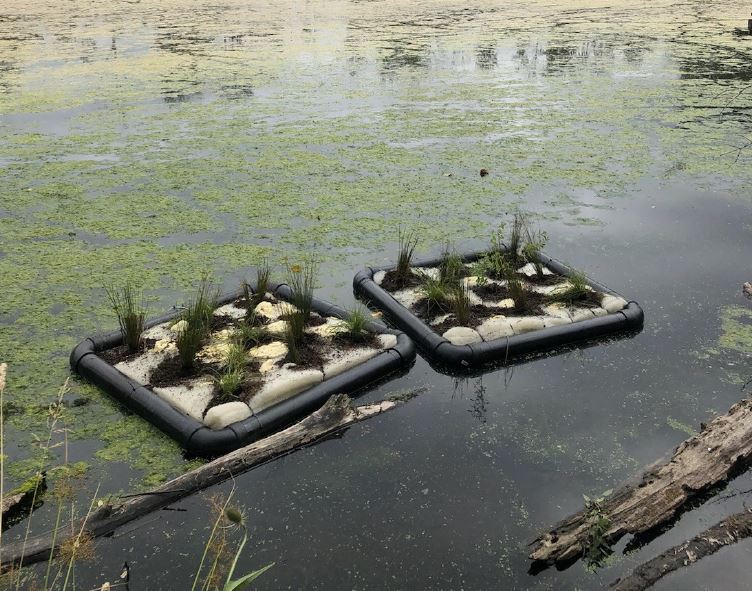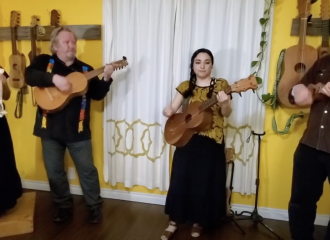The wildfires in our region during the summer of 2020 sparked a renewed conversation about the urgent need to address climate change. For six local teenagers, however, it was conversations about the temperature of the water that made the topic real last summer.
And they’re doing something about it.
The Columbia Slough is a 19-mile-long complex of narrow and shallow channels located south of the Columbia River between Fairview Lake and the Willamette River. Historically, the Columbia Slough watershed featured lakes, wetlands and slow-moving channels that received seasonal flooding from the Columbia River. Today, the watershed is highly urbanized and is managed for flood control with levees and pumps but remains an important safe haven for local wildlife and nature.
The Slough also has elevated water temperatures, and that’s not good.
When the water warms, combined with excess nutrients, it leads to excessive plant growth and algal blooms. These blooms absorb sunlight, making water even warmer and promoting more blooms. It is a negative feedback cycle that reduces the amount of oxygen in the water and suffocates fish and natural vegetation that is important to local animals like ducks and turtles.
The Columbia Slough Watershed Council (CSWC), a longtime Port partner, had a creative idea that might help: could floating wetlands cool the water? A floating wetland is essentially a human-made raft that floats on the water’s surface and houses native wetland plants. They help remove excess nutrients and pollutants and increase water quality.

CSWC engaged the Blueprint Foundation to get their answer. Blueprint prepares Black youth in the Portland area for careers in environmental science and green building through experiential learning. Through a series of workshops led by CSWC, six local youth learned about wetland ecology and design and created mini prototypes for their floating wetlands. Then, they built full-scale models to test for a few months.
“I was surprised with how quickly the kids got into this work. They dug into the project and got creative so fast. I loved watching them use their intuition to learn and grow,” said Max Samuelson, stewardship director for the Columbia Slough Watershed Council.
The six teenagers learned a lot from their initial designs. Two big lessons, in fact. First, their initial designs were not durable enough and fell apart. Second, ducks loved the floating wetlands … a little too much. Their next design had to withstand the damage that ducks inflicted when they were eating and lounging in the sun on the top of the floating wetland.
“This project is about learning first, and environmental outcomes second. It was important to us that we gave these students new math and design skills in a fun, creative way,” Max shared. “It was really cool to see the students come to the solutions on their own. They also learned an important design and engineering lesson: first trials don’t usually work.”
After monitoring and assessing their original designs, the teenagers regrouped to build new and improved versions. They created four new floating wetlands using two different designs. One used synthetic material like plastic tubing, marine foam, and pond matting. The other used more natural materials, including cork, bamboo and erosion matting.
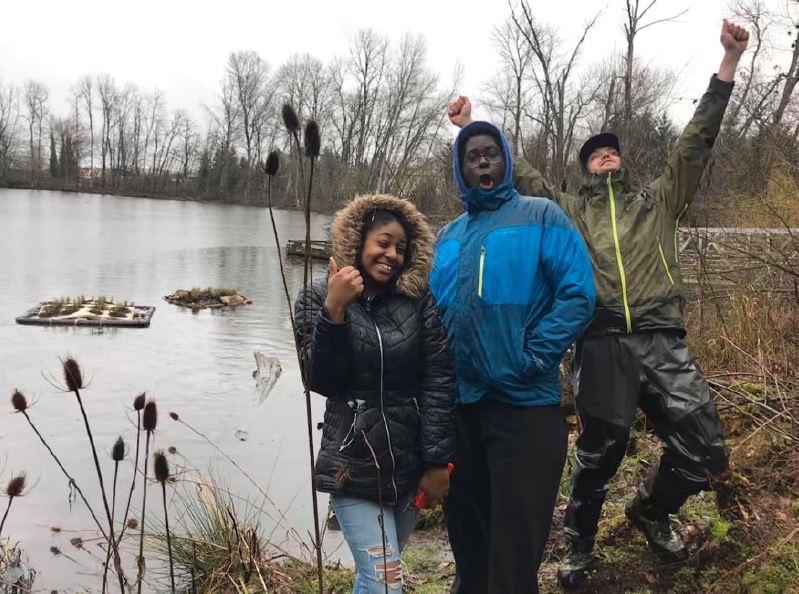
“What I like about this project is how much it contributes to nature and our wildlife. It is important we take care of our land, our air, our water, our everything,” said TreVon Frison, a 2020 graduate of Roosevelt High School and 3-year participant in Blueprint (pictured in the middle in the photo above).
After rolling out their final designs last July, the students’ work was done. But it certainly wasn’t forgotten.
“It was great to witness our students work together as a team to implement a practical solution to an observed challenge to their local watershed’s health and for them to know their efforts will have a lasting positive impact,” said Jason Stroman, program director at the Blueprint Foundation. “This is the very essence of experience that Blueprint aims to provide its youth, knowing that it will encourage, empower, and inspire them and their peers towards greatness in all aspects of life.”
CSWC is now monitoring the floating wetlands through photos, water samples and temperature checks. Their hope is that they’ll see cooler temperatures and nutrients in the water and can replicate these designs throughout the Slough. All thanks to six teenagers. The future is bright.
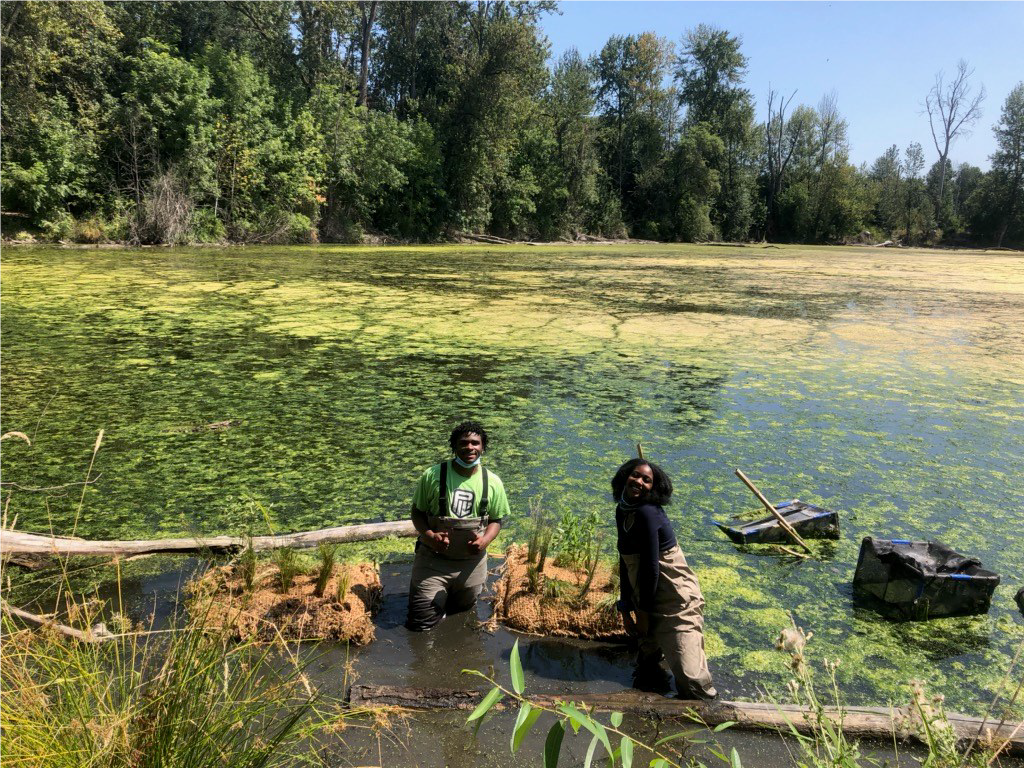
10 Years of Environmental Partnership
This partnership with CSWC and the Blueprint Foundation was funded through the Airport Futures natural resources program, which the Port has been implementing for the last 10 years. Components of the program include wetland enhancements, grassland mitigation, and watershed and tree canopy enhancements.
The Airport Futures natural resources program was an outcome of Airport Futures, a collaborative effort between the Port, City of Portland, and the Portland-Vancouver metropolitan community to create an integrated long-range development plan for PDX. The natural resources program components were memorialized in an intergovernmental agreement between the Port and the City of Portland and is overseen by the PDX Community Advisory Committee (CAC).
A natural resources subcommittee – made up of members including the City of Portland, Metro, Audubon Society, Verde, CSWC, and Multnomah County Drainage District – review and select the projects that are brought to the CAC for final approval. Projects must meet certain selection criteria to be considered.
Over the last decade, this program has funded 13 projects focused on slough enhancement, totaling more than $340,000, and $230,000 in funding has helped Friends of Trees plant nearly 8,800 trees and shrubs in neighborhoods and greenspace surrounding PDX.
| Fiscal Year | Slough Enhancement Project | Funding Amount |
| 2011/12 | Verde Cully Community Park North Slope Restoration | $30,000 |
| 2012/13 | MCDD Elrod Slough Restoration | $30,900 |
| 2013/14 | CSWC Whitaker Ponds Turtle Enhancement Project | $7,000 |
| 2014/15 | Port Buffalo Slough Turtle Enhancement Project | $18,329 |
| 2015/16 | CSWC Better Beaver Behavior and Main Stem Bench and Island Planting Projects | $46,363 |
| 2016/17 | CSWC Vegetation Maintenance | $34,778 |
| 2017/18 | CSWC NE 33rd Riparian Corridor Enhancement Project (year 1) | $6,655 |
| MCDD Columbia Slough Islands Restoration (year 1) | $10,850 | |
| Audubon Backyard Habitat Certification Program | $5,000 | |
| Verde Cully Park’s North Slope Habitat Restoratio Project | $40,000 | |
| 2018/19 | CSWC NE 33rd Riparian Corridor Enhancement Project (year 2) | $10,450 |
| MCDD Columbia Slough Islands Restoration (year 2) | $10,580 | |
| CSWC ACME Riparian Restoration Project | $15,866 | |
| 2019/20 | CSWC Engineered Wetland in Whitaker Ponds | $16,550 |
| Verde Cully Community Rain Garden Project | $20,823 |

